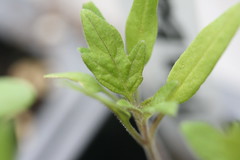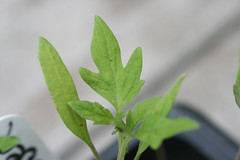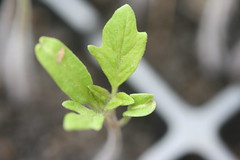



I did the testing because my tomato plants had terribly curled and leathery leaves, tall spindly growth, and very few fruits this year. I had brought in purchased loam and compost this spring, since we have a new property and I don't have my own compost yet and needed to new fill raised beds. For the test, I planted the same tomato seeds in samples of 4 different soils: 1) purchased compost, 2) the mixed soil from the tomato bed (a mix of purchased compost and purchased loam), 3) soil from my lettuce bed (no purchased compost or loam in this), and 4) soil from our yard below the garden beds. Representative primary leaves of seedlings grown in these 4 samples are shown in the same order above.
I think the secondary leaves of the compost-grown test plants look leathery and curled just like my garden plants. The mixed tomato bed soil is sort-of leathery, but the green's bed plants look great. The sub-soil plants are yellow reflecting the lack of nutrients in this soil.
I find it disappointing that purchased compost is toxic to tomato plants. I live in a fairly urbanized area and the compost I bought was made from local yard waste.
Janice, who lives south of me in CT, emailed me and wrote that she contacted an organic farmer last year about a source for good composted manure and he warned about toxic manures these days due to lingering herbicides in animal feed and recommended sticking with home composting and cover crops. It seems this animal feed toxicity is often a problem now in garden composts. Herbicides used on lawns aren't as toxic or persistent as for example, Roundup, which is what is sprayed on the Roundup Ready (GMO) corn used for animal feed. So my compost should have been OK if it was just suburban grass clippings and leaves with suburban lawn chemicals. But it seems its not OK as my tomatoes didn't grow well at all in it. I'm really disappointed that there are so many chemicals in use that we can't buy a safe compost product. I look forward to producing my own compost and not being in a position where I need to purchase compost or loam for my gardens.
9 comments:
I had heard about this problem which has affected many growers in UK. Only way to be sure what you are using is to make your own I guess - bit difficult if you don't keep animals and want manure though! And if it does this to the plants what would it do to us if we did eat the produce I wonder?
Their growth is defiantly distorted. I'm surprised a composted product would cause that too.
I suppose though that if you aren't making your own compost it's like a lucky dip as to what you get.
Thanks for sharing this info. I used purchased compost and also notice curled leaves on my pepper
plants.
Janice in NY
My garden was made with compost from suburbia too. Luckily I didn't have your trouble. But I think every disease known to man was in that soil. I never had these disease problems at my last house, but there I made all my own compost. I try to make my own here, but I can't make quite enough for the whole garden. Almost but not quite. So every year I have to buy a little bit.
Bleh. They get you coming and going !!
The difference in leaf growth is obvious which is disturbing about the purchased compost. I used purchased compost last year too, which is mainly tree waste from our rural town's compost/mulch program. Luckily we didn't get the herbicide issues. Over the last four years the tilth of our garden soil has been completely transformed from awful clay using homemade compost and mulch.
I find it strange that whatever it is in the compost is only affecting the tomatoes. I had only very small amounts of leaf curling on the cukes and peppers, and nothing else in the same soil was affected. Hmmm...
Today I am having a great time (ha!) pulling crab grass in my lawn by hand. I don't like the look of it. It wasn't there last summer when we bought the house, but this year it has invaded everywhere. My guess is the previous owner used some herbicide or suppressant. I don't want to contribute to putting chemicals into the environment - so I'm hand pulling. And seeding. This weekend we are focusing on the lawn - seed, fertilize, lime, and start watering. Hopefully we will eventually have an all organic lawn without crabgrass (but WITH lots of clover and ajuga).
Thanks Joe.
It has been banned in Washington State, but I guess not here. Wikipedia says it's "particularly damaging to peas, tomatoes and sunflowers and can render potatoes, lettuce and spinach inedible". Cool. No wonder my sunflowers didn't sprout. I kept planting and replanting the seeds.
I tried to look up the resistance time of clopyralid in soils. Couldn't find info. I guess I will find out myself if my tomatoes or sunflowers grow next year....
I meant persistence time, not resistance.....
Post a Comment